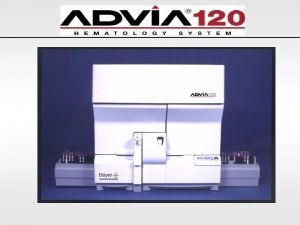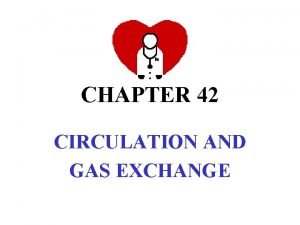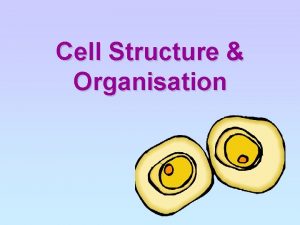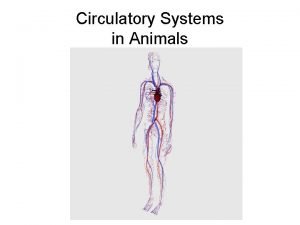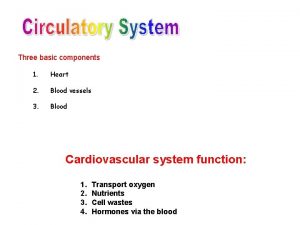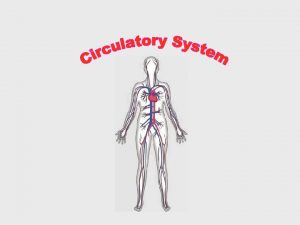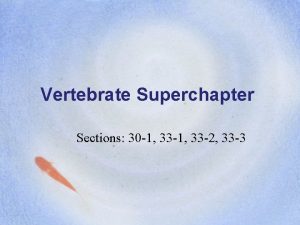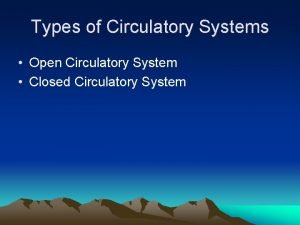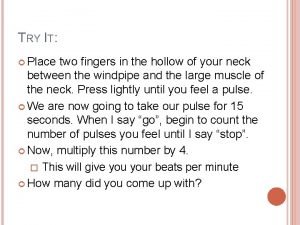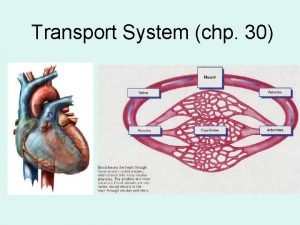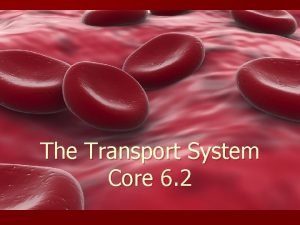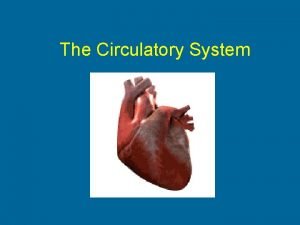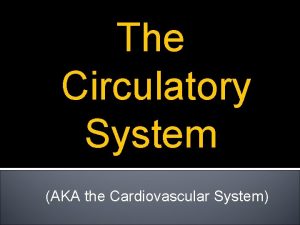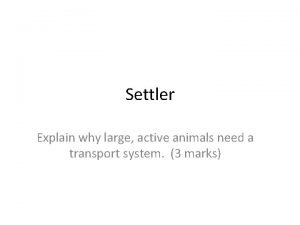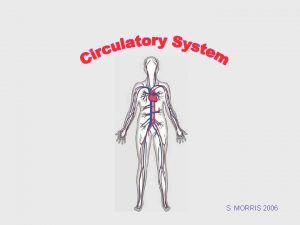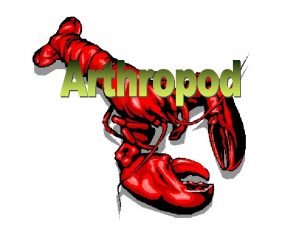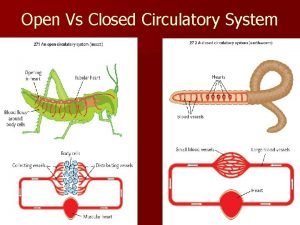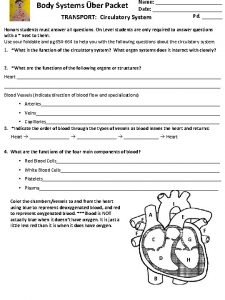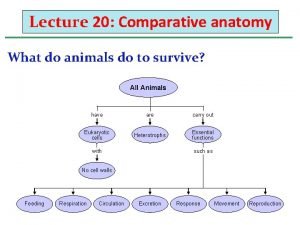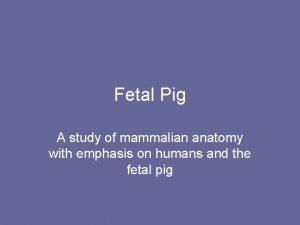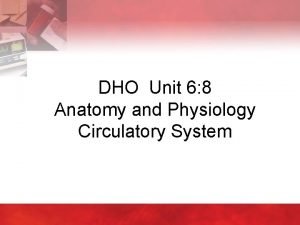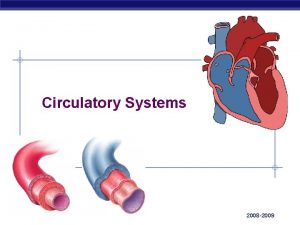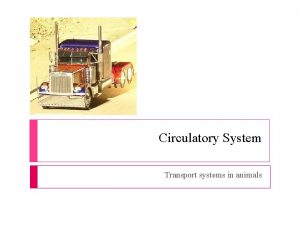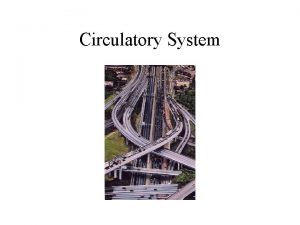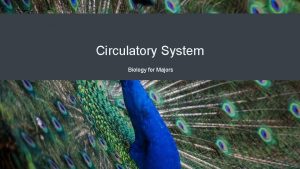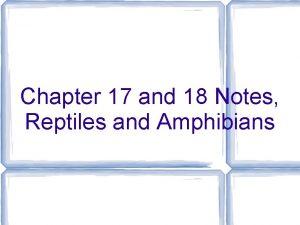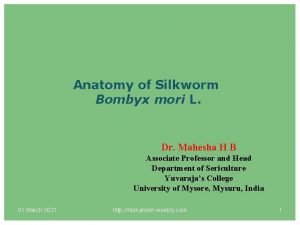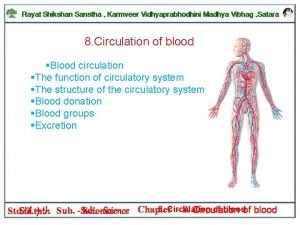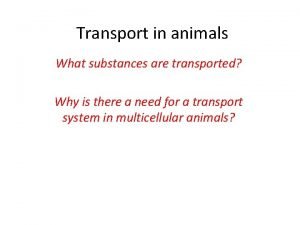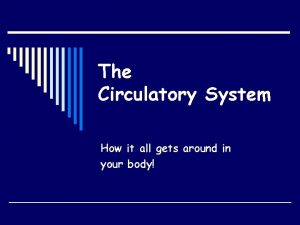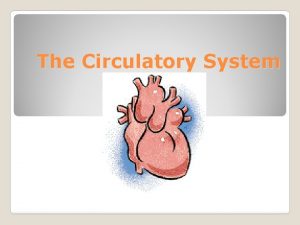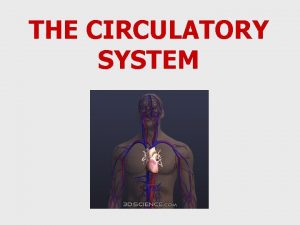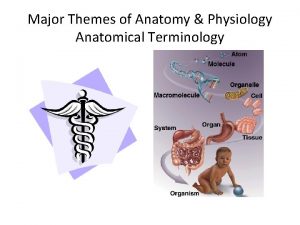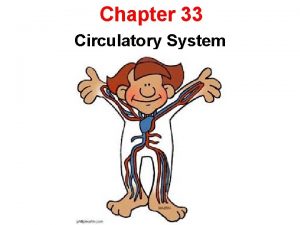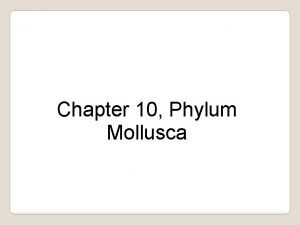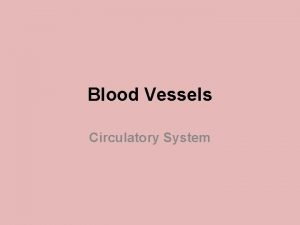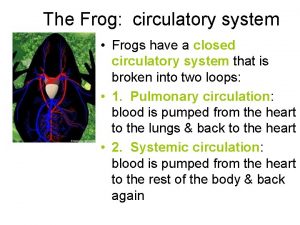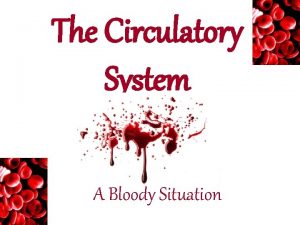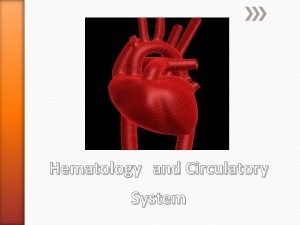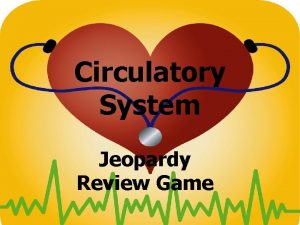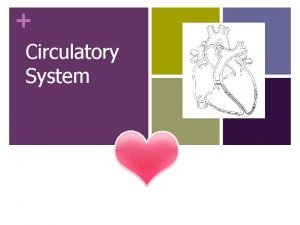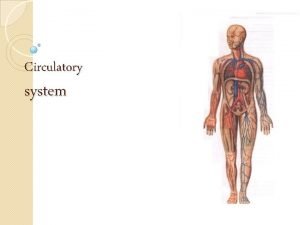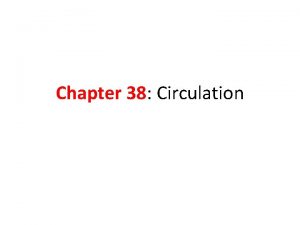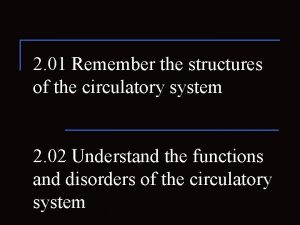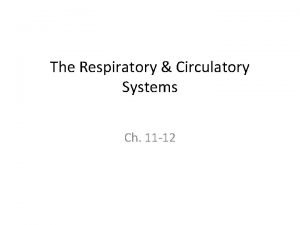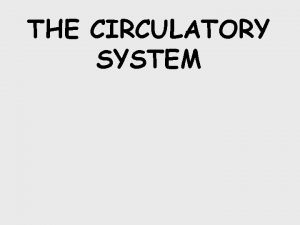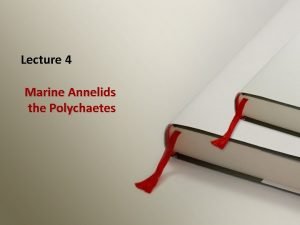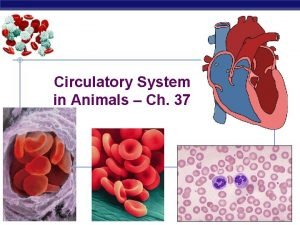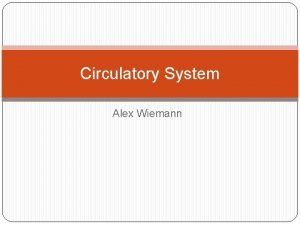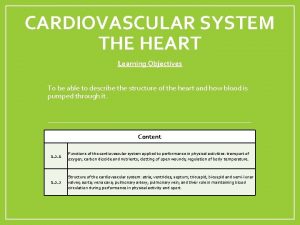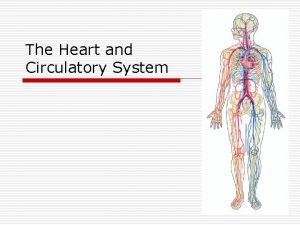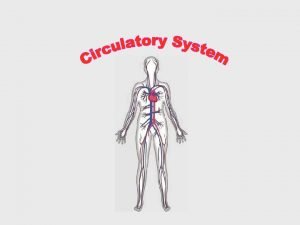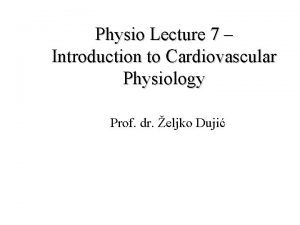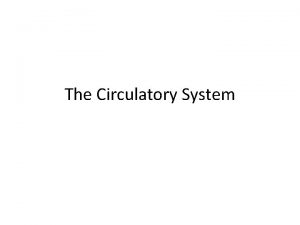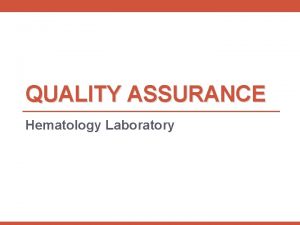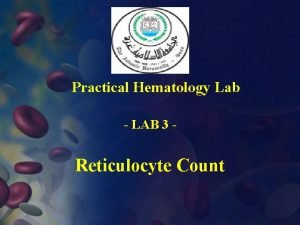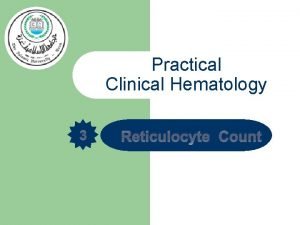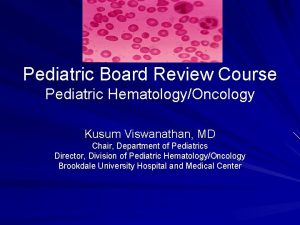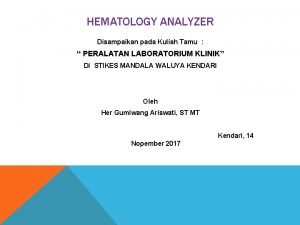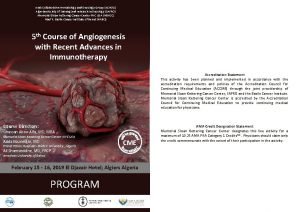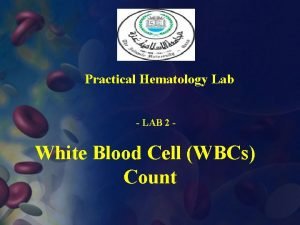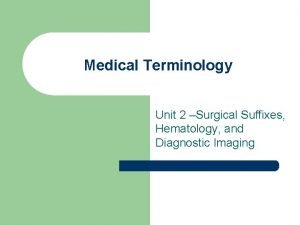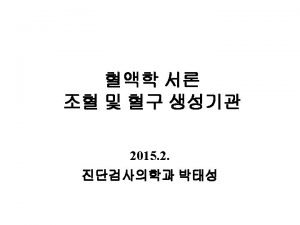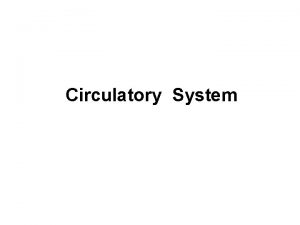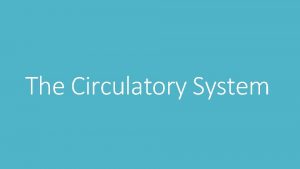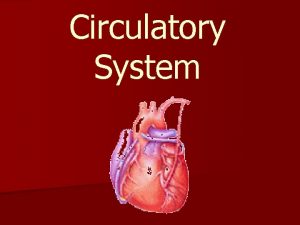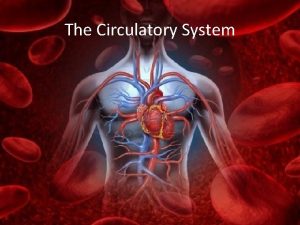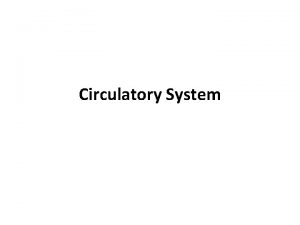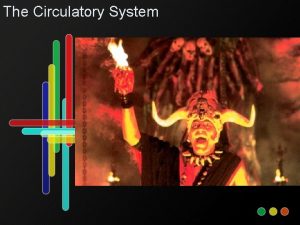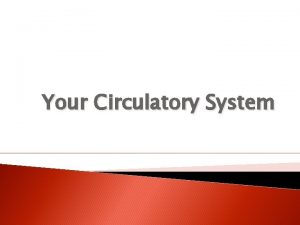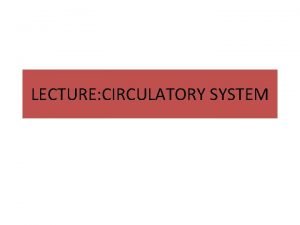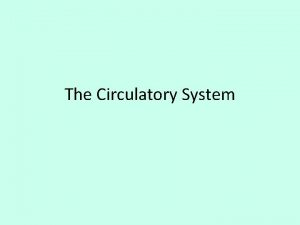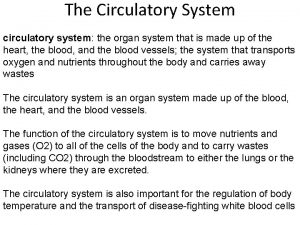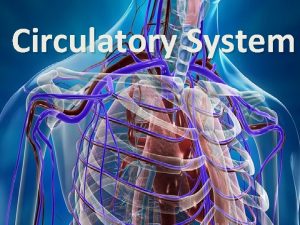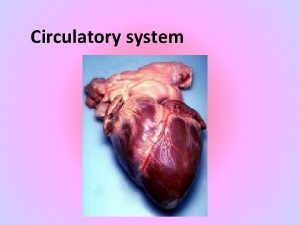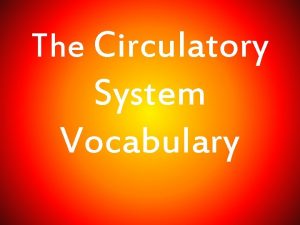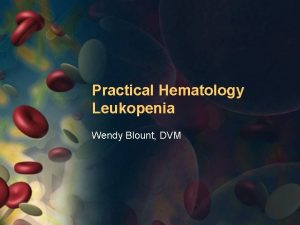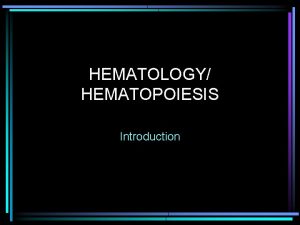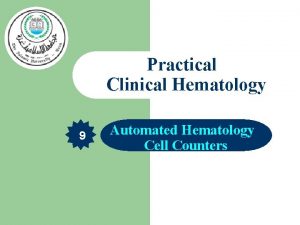Hematology and Circulatory System Structures of the circulatory
















































































- Slides: 80

Hematology and Circulatory System

Structures of the circulatory system q Blood q Heart q Arteries q Veins q Capillaries 2. 01 Remember the structures of the circulatory system 2

Blood n n Hemat- = blood -ology = the study of The average adult has 8 – 10 pints. n 2. 01 Remember the structures of the circulatory system 3

Blood One drop of blood contains: q q q 5 million RBCs 250, 000 -500, 000 platelets 7, 500 WBCs Red blood cells live 120 days. Make new blood cells 2 million per second! 2. 01 Remember the structures of the circulatory system 4

Structures of the blood n n Plasma Erythrocytes Leukocytes Thrombocytes 2. 01 Remember the structures of the circulatory system 5

Plasma n Straw-colored liquid n Blood without cellular components n 55% of the blood’s volume q Water q Plasma proteins q Nutrients q Electrolytes q Hormones, vitamins, and enzymes q Waste products Plasma Cellular elements 2. 01 Remember the structures of the circulatory system 6

Plasma proteins n Fibrinogen - Necessary for blood clotting, synthesized in liver n Albumin - From the liver, helps maintain blood’s osmotic pressure and volume n Globulin q Gamma globulin q Plasma Cellular elements Prothrombin - helps blood coagulate. Vitamin K necessary for prothrombin synthesis 2. 01 Remember the structures of the circulatory system 7

Erythrocytes n n Biconcave disk Hemoglobin - Gives red color, heme is iron and globin is protein n Transportation q q n Arterial blood q q n Oxygen Carbon dioxide Lots of oxygen Bright red Venous blood q q Lots of CO 2 Dark crimson 2. 01 Remember the structures of the circulatory system 8

Erythrocytes 2. 01 Remember the structures of the circulatory system 9

Leukocytes n n Larger than erythrocytes Five types Leuk/o/cytes – white cells 2. 01 Remember the structures of the circulatory system 10

Leukocytes n Agranulocytes q q Lymphocytes Monocytes 2. 01 Remember the structures of the circulatory system 11

Leukocytes n Granulocytes q q q n Neutrophils Eosinophils Basophils Phagocytosis q Process when white cells surround, engulf, and digest harmful bacteria…. used by granulocytes and monocytes 2. 01 Remember the structures of the circulatory system 12

Agranulocyte VS Granulocyte 2. 01 Remember the structures of the circulatory system 13

Clip n https: //www. youtube. c om/watch? v=z. QGOc OUBi 6 s 2. 01 Remember the structures of the circulatory system 14

Thrombocytes q q Smallest of solid components of blood Synthesized in red marrow Not cells, composed of fragments of cells Necessary for the initiation of the blood clotting process 2. 01 Remember the structures of the circulatory system 15

What does it really look like all together? ? 2. 01 Remember the structures of the circulatory system 16

Clip n https: //www. youtube. c om/watch? v=CRh_d. A z. Xuo. U 2. 01 Remember the structures of the circulatory system 17

2. 01 Remember the structures of the circulatory system 18

Blood types n Inherited from parents q Determined by presence or absence of an antigen on the surface of the red blood cell 2. 01 Remember the structures of the circulatory system 19

n In 1901, the Austrian immunologist Karl Landsteiner discovered that blood may be grouped into four main types. n Based on the reaction that resulted when blood from different individuals were mixed. 2. 01 Remember the structures of the circulatory system 20

Blood types q q Someone with type A antigen has B antibodies Someone with type B antigen has A antibodies Someone with type AB antigen has no antibodies Someone with type O antigen has A and B antibodies 2. 01 Remember the structures of the circulatory system 21

Rh factor n Rhesus (Rh) factor is an inherited trait that refers to a specific protein found on the surface of red blood cells (antigen). n Blood used in transfusions must match donors for Rh status as well as for ABO blood type. n Although Rh factor doesn't affect the patient’s health, it can affect pregnancy. 2. 01 Remember the structures of the circulatory system 22

Rh factor n In 1940, the Rh factor was discovered as a result of studying Rhesus monkeys. n When blood from monkeys was injected into rabbits and guinea pigs, it clotted. 2. 01 Remember the structures of the circulatory system 23

Rh factor n If the blood has the protein, the patient is Rh positive. n If the blood lacks the protein, the patient is Rh negative. 2. 01 Remember the structures of the circulatory system 24

If the mom gets pregnant again with another Rh + positive, her anti Rh antibodies will attack the baby’s blood, causing ERYTHROBLASTOSIS FETALIS. RHO Gam will destroy any baby blood cells in the mom, & her immune system won’t produce antibodies. 2. 01 Remember the structures of the circulatory system 25

Structures of the circulatory system q Heart 2. 01 Remember the structures of the circulatory system 26

Heart The heart is a double pump. 2. 01 Remember the structures of the circulatory system 27

Heart Aorta Superior vena cava Pulmonary artery Aortic semilunar valve Pulmonary vein Right atrium Left atrium Tricuspid valve Bicuspid (mitral) valve Inferior vena cava Pulmonary semilunar valve Right ventricle Left ventricle Septum Apex 2. 01 Remember the structures of the circulatory system 28

Layers of the heart Left atrium Right atrium Pericardium Myocardium Endocardium Right ventricle Left ventricle 2. 01 Remember the structures of the circulatory system 29

2. 01 Remember the structures of the circulatory system 30

2. 01 Remember the structures of the circulatory system 31

Blood supply to the Heart – ARTERIES from CORONARY Heart Sounds = lubb dupp

Control of Heart Contractions SA (sinoatrial) NODE = PACEMAKER n n Located in right atrium SA node sends out electrical impulse Impulse spreads over atria, making them contract Travels to AV Node AV (atrioventricular) NODE n n Conducting cell group between atria and ventricle Carries impulse to bundle of His

BUNDLE OF HIS n n Conducting fibers in septum Divides into R and L branches to network of branches in ventricles PURKINJE FIBERS n Impulse shoots along Purkinje fibers causing ventricles to contract



Conduction system of heart beats AV bundle or Bundle of HIS Septum 2. 01 Remember the structures of the circulatory system 37

EKG…What exactly is it? ? ? n n An EKG is a test that shows the electrical functions of the heart The P wave is left and right atrial depolarization(change in the cell's membrane potential to a more positive state) 2. 01 Remember the structures of the circulatory system 38

QRS…What is it? ? n depolarization of the right and left ventricles of the human heart. 2. 01 Remember the structures of the circulatory system 39

T Wave…what is it? ? ? n repolarization (or recovery) of the ventricles 2. 01 Remember the structures of the circulatory system 40

What about abnormal EKGs? ? ? n n Atrial Fibrillation: In AF, the heart's electrical signals don't begin in the SA node. Instead, they begin in another part of the atria or in the nearby pulmonary veins. The signals don't travel normally. They may spread throughout the atria in a rapid, disorganized way. This can cause the atria to fibrillate. 2. 01 Remember the structures of the circulatory system 41

Abnormal EKG’s n Ventricular Tachycardia: n regular and fast heart rate that arises from improper electrical activity in the ventricles of the heart 2. 01 Remember the structures of the circulatory system 42

Abnormal EKG’s n n Asystole: (flatline) a state of no electrical activity from the heart and therefore no blood flow. It results in cardiac arrest 2. 01 Remember the structures of the circulatory system 43

Vessels of the circulatory system n ARTERIES q Carry oxygenated blood away from the heart to the capillaries Elastic, muscular and thick-walled Transport blood under very high pressure q Arteries > arterioles > capillaries q q 2. 01 Remember the structures of the circulatory system 44

Arteries 2. 01 Remember the structures of the circulatory system 45

Vessels of the circulatory system n VEINS q q q Carry deoxygenated blood away from capillaries to the heart Veins contain a muscular layer, but less elastic and muscular than arteries Thin walled veins collapse easily when not filled with blood Veins have values that permit flow of blood only in direction of the heart Veins > Venules > Capillaries 2. 01 Remember the structures of the circulatory system 46

Veins 2. 01 Remember the structures of the circulatory system 47

Structures of the circulatory system q Capillaries n The smallest blood vessels n Connect arterioles to venules One cell thick…made of endothelial tissue 2. 01 Remember the structures of the n circulatory system 48

Capillaries 2. 01 Remember the structures of the circulatory system 49

Blood Pressure Surge of blood when heart pumps creates pressure against the walls of the arteries SYSTOLIC PRESSURE - measured during the contraction phase – (contraction phase of the heart is called systole) DIASTOLIC PRESSURE - measured when the ventricles are relaxed – (relaxation phase is called diastole) 2. 01 Remember the structures of the circulatory system 50

BP and Pulse sites Average systolic = 120 Average diastolic = 80 PULSE - alternating expansion and contraction of an artery as blood flows through it. Pulse Sites: Brachial, Carotid, Radial, Popliteal, Pedal – Where are they? ? ? n Find pulse sites and take BP 2. 01 Remember the structures of the circulatory system 51

Common pulse sites 2. 01 Remember the structures of the circulatory system 52

What are the functions of blood? Transportation n What does the blood transport? n Why is this an important function? 2. 02 Understand the functions and disorders of the circulatory system 53

What are the functions of blood? Regulation n How does the blood regulate heat? Aids in distribution of heat formed in more active tissues n like skeletal muscle n How does the blood regulate acid/base balance? 2. 02 Understand the functions and disorders of the circulatory system 54

Acid/Base Balance n A p. H of 7 is neutral. The lower the p. H, the more acidic the blood. A variety of factors affect blood p. H including what is ingested, vomiting, diarrhea, lung function, endocrine function, kidney function, and urinary tract infection. The normal blood p. H is tightly regulated between 7. 35 and 7. 45. 2. 01 Remember the structures of the circulatory system 55

What are the functions of blood? Protection n What function of the blood serve to protect the body? n What is the relevance to health? 2. 02 Understand the functions and disorders of the circulatory system 56

Erythropoiesis n Manufacturing of RBC’s, occurs in bone marrow, until adolescence, then in short and flat bones 2. 01 Remember the structures of the circulatory system 57

Erythrocytes n hemolysis q q Starts here What is it? Rupturing of RBCs Where does it occur? blood transfusion reaction or other disease What is the lifetime of an erythrocyte? 120 days What happens to old erythrocytes? Broken down by spleen and liver; iron content used to make new RBC’s 2. 02 Understand the functions and disorders of the circulatory system 58

Inflammation 2. 02 Understand the functions and disorders of the circulatory system 59

INFLAMMATION 2. 01 Remember the structures of the circulatory system 60

INFLAMMATION n n n Dirty nail punctures skin Bacteria enter and multiply Injured cells release histamines Blood vessels dilate and become permeable, releasing inflammatory exudate Blood flow to damaged area increases Neutrophils move toward bacteria and destroy them by phagocytosis 2. 01 Remember the structures of the circulatory system 61

AGGLUTINATION 2. 01 Remember the structures of the circulatory system 62

Disorders n • • • ANEMIA Deficiency in number or % of red blood cells IRON-DEFICENCY ANEMIA Usually in women, children and adolescents Deficiency of iron in the diet causing in sufficient hemoglobin synthesis Treat with iron supplements and green, leafy vegetables

PERNICIOUS ANEMIA • Caused by deficiency of B 12 or intrinsic factor (produced by stomach mucosa, necessary for absorption of B 12) • Symptoms – dyspnea, pallor, fatigue, & neurologic changes • Treatment – injections of B 12 APLASTIC ANEMIA • Bone marrow does not produce enough red & white blood cells • Caused by drugs or radiation therapy 2. 01 Remember the structures of the circulatory system 64

n • • • SICKLE CELL ANEMIA Chronic blood disease inherited from both parents Causes the red cells to form in abnormal sickle shape Siclke cells break easily & carry less oxygen Occurs primarily in blacks Treatment – blood transfusions COOLEY’S ANEMIA Also known as Thalassemia Major Caused by a defect in hemoglobin Affects people of Mediterranean descent

n • • POLYCYTHEMIA Too many red blood cells are formed May be a temporary condition that occurs at high altitude EMBOLISM Air, blood clot, cancer cells, fat, etc. That is carried by the bloodstream until it reaches an artery too small for passage Also known as a “moving blood clot” THROMBOSIS The formation of a blood clot in a blood vessel The blood clot is a THROMBUS

n • • • n • • HEMATOMA Localized clotted mass of blood found in an organ, tissue or space Caused by an injury that can cause a blood vessel to rupture HEMOPHILIA Hereditary Missing clotting factor Blood clots slow or abnormally Sex-linked – transmitted genetically from mother to sons Treat with missing clotting factor, avoid trauma THROMBOCYTOPENIA Not enough platelets Blood will not clot properly

n • • • n • LEUKEMIA Malignant condition Overproduction of immature white blood cells Hinders synthesis of red cells SEPTICEMIA Presence of pathogens or toxins in the blood

• Pus- cream colored liquid • Abscess- pus filed cavity • Pyrexia- fever • Leukocytosis-increase in white blood cell count (>10, 000 per cubic centimeter) • Edema-excessive fluid in tissues

Circulatory disorders n Varicose veins n Prevention q q q Wear sunscreen Elevate legs when resting Wear elastic support stockings Eating fiber diets Exercise Weight control 2. 02 Understand the functions and disorders of the circulatory system 70

Circulatory disorders n Transient ischemic attack 2. 02 Understand the functions and disorders of the circulatory system 71

Circulatory disorders n Pulmonary edema 2. 02 Understand the functions and disorders of the circulatory system 72

Circulatory disorders n Peripheral vascular disease 2. 02 Understand the functions and disorders of the circulatory system 73

Circulatory disorders n Myocardial infarction 2. 02 Understand the functions and disorders of the circulatory system 74

Circulatory disorders n Murmurs 2. 02 Understand the functions and disorders of the circulatory system 75

Circulatory disorders n Heart failure 2. 02 Understand the functions and disorders of the circulatory system 76

Circulatory disorders n n n Angina pectoris Severe chest pain that arises from heart not receiving enough O 2 2. 02 Understand the functions and disorders of the circulatory system 77

Aneurysm n n n Ballooning of an artery through a thinned out arterial wall; caused by weakening of blood vessel Pain and pressure Treatment of brain aneurysm: surgery 2. 01 Remember the structures of the circulatory system 78

Blood disorders n Multiple myeloma What is multiple myeloma? What are the symptoms? How is it treated? 2. 02 Understand the functions and disorders of the circulatory system 79

Two Types of Circulation n n Systemic: circulation that carries blood throughout the body Cardiopulmonary: circulation that carries blood from heart to lungs and back 2. 01 Remember the structures of the circulatory system 80
 Digestive system circulatory system and respiratory system
Digestive system circulatory system and respiratory system Circulatory system and respiratory system work together
Circulatory system and respiratory system work together How are the whale flipper and the human arm different
How are the whale flipper and the human arm different Tiny air sacs at the end of the bronchioles
Tiny air sacs at the end of the bronchioles Hypochrmic
Hypochrmic Difference between open and closed circulatory system
Difference between open and closed circulatory system Identify the cell
Identify the cell Reptile circulatory system
Reptile circulatory system 3 main functions heart
3 main functions heart University of north carolina hematology oncology fellowship
University of north carolina hematology oncology fellowship Circulatory system steps in order
Circulatory system steps in order Superchp
Superchp Lungfish circulatory system
Lungfish circulatory system Circulatory system of clams
Circulatory system of clams Circulatory system of a cow
Circulatory system of a cow Circulatory system function
Circulatory system function Closed circulatory system
Closed circulatory system Jobs of the circulatory system
Jobs of the circulatory system 3 parts of the circulatory system
3 parts of the circulatory system Active animals
Active animals How circulatory system work
How circulatory system work What makes up the cardiovascular system
What makes up the cardiovascular system Gas exchange in circulatory system
Gas exchange in circulatory system Single circulation and double circulation
Single circulation and double circulation Arthropoda
Arthropoda Arthropoda phylogeny
Arthropoda phylogeny Open circulatory system vs closed
Open circulatory system vs closed Circulatory system foldable
Circulatory system foldable Invertebrate circulatory system
Invertebrate circulatory system Respiratory system fetal pig
Respiratory system fetal pig Unit 6:8 circulatory system
Unit 6:8 circulatory system Open circulatory system
Open circulatory system Invertebrate circulatory system
Invertebrate circulatory system Circulatory system function
Circulatory system function Main function of the circulatory system
Main function of the circulatory system Arthropods circulatory system
Arthropods circulatory system Chapter 34 section 1 the circulatory system
Chapter 34 section 1 the circulatory system Reptile circulatory system
Reptile circulatory system Silkworm diagram
Silkworm diagram Function of the circulatory system
Function of the circulatory system Transport substances in animals
Transport substances in animals Circulatory system interactions with other systems
Circulatory system interactions with other systems Vena cava function in circulatory system
Vena cava function in circulatory system Abo wikipedia
Abo wikipedia The circulatory or cardiovascular system chapter 19
The circulatory or cardiovascular system chapter 19 Circulatory system
Circulatory system Major function of digestive system
Major function of digestive system Chapter 33 section 1 the circulatory system
Chapter 33 section 1 the circulatory system Characteristics of phylum mollusca
Characteristics of phylum mollusca Blood vessels circulatory system
Blood vessels circulatory system Circulatory system frog
Circulatory system frog Circulatory system
Circulatory system Monkey circulatory system
Monkey circulatory system Circulatory system jeopardy
Circulatory system jeopardy Circulatory system trivia
Circulatory system trivia Circulatory system in a sentence
Circulatory system in a sentence The circulatory system
The circulatory system Magic school bus circulatory system
Magic school bus circulatory system Respiratory system quizizz
Respiratory system quizizz Salamander circulatory system
Salamander circulatory system Circulatory system
Circulatory system Agranulocytes
Agranulocytes Digestive system of polychaeta
Digestive system of polychaeta Evolution of circulatory system
Evolution of circulatory system Types of circulatory system
Types of circulatory system Double circulatory system
Double circulatory system Circulatory system
Circulatory system Blood vessels
Blood vessels Parts of blood
Parts of blood Pressure in circulatory system
Pressure in circulatory system Pulmonary circuit and systemic circuit
Pulmonary circuit and systemic circuit How to remember the circulatory system
How to remember the circulatory system Structure of blood vessels
Structure of blood vessels Hematology laboratory procedures
Hematology laboratory procedures Miller disc method
Miller disc method Normal reticulocyte count
Normal reticulocyte count Pediatric hematology oncology board review
Pediatric hematology oncology board review Hematology analyzer diagram
Hematology analyzer diagram Achog
Achog Wbc pipette wikipedia
Wbc pipette wikipedia Ostomy medical term suffix
Ostomy medical term suffix




